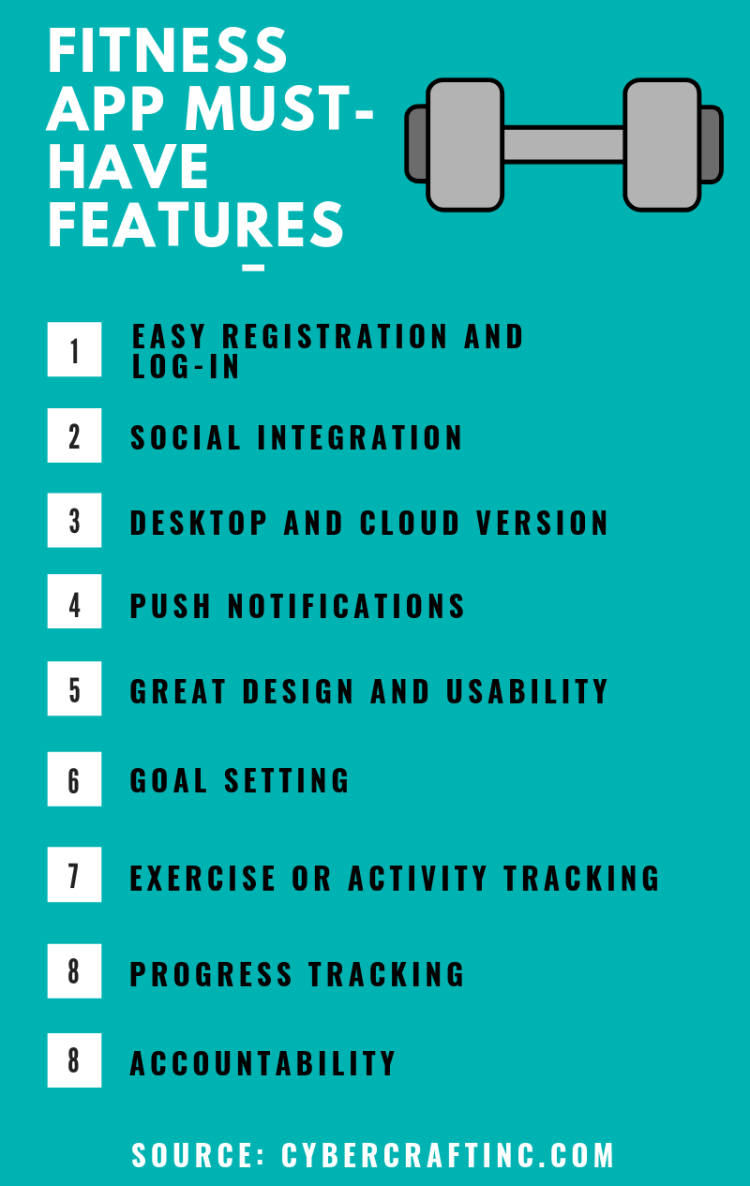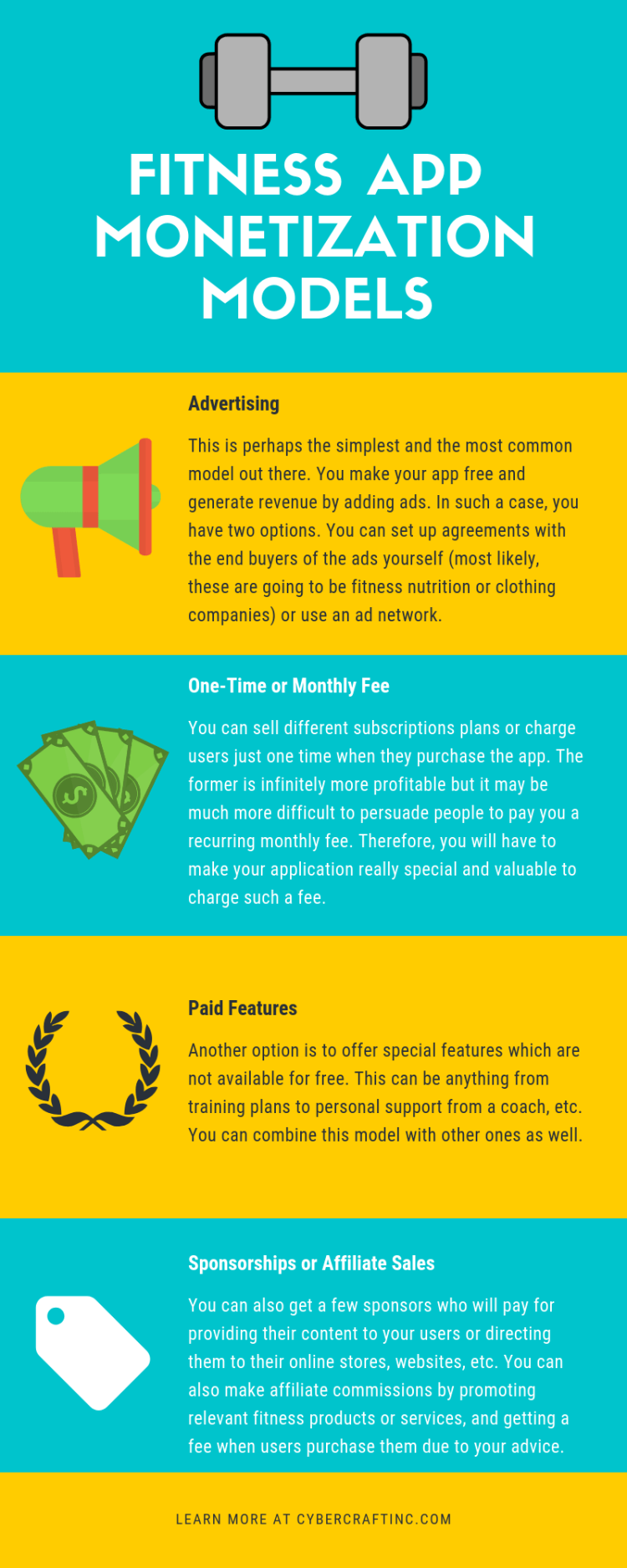Fitness App Types
Fitness and healthy living have become major trends in our society these days. More and more people are taking up fitness, weightlifting, running, crossfit and healthy dieting. It has become “cool” to be fit and healthy. As the global fitness community grows, an entire ecosystem gets built around it: fitness celebrities on Instagram, Youtube channels, conferences, magazines, etc.
Along with this new trend, there is another one in the technology world – mobile apps. As more and more people are becoming active smartphone users (2.5 billion in 2019), there appears demand for all types of mobile apps. On Google Play alone, there are over 2 million apps, and almost that many on AppStore. The market of mobile apps is impressively large and growing – it is expected to reach 188.9 billion dollars in annual revenue in 2020.
There are many big niches in this market. One of them is fitness apps. The fitness app market currently exceeds 2 billion dollars and is expected to grow up to over 14 billion dollars in 2026. If you’re planning to start a new venture, you definitely want to be in the growing market. Fitness app market is this kind of market.
Therefore, what we’re seeing is that fitness apps are a big trend which you can take advantage of (if you do it the right way). Today we will explain in deep detail how to it successfully. Let’s get started!
Fitness App Types
In case you still don’t know not all fitness apps are the same. There exist different types of them which serve different purposes. We are going to list the most popular types:
- Training & Exercise
- Diet & Meals
- Personal Training / Fitness Celebrity Branded Apps
- Multi-purpose
- Tracking
- Wellness (yoga, meditation, etc.)

If you are going to build a fitness app, you will have to determine the right type for your application or combine a few into one. Let’s analyze each of these variations in detail.
Training & Exercise Fitness App
These kinds of apps provide users with detailed training plans, exercise videos and explanations of how to do exercises. A great training app should include customization i.e. create a training plan based on the user’s goals and preferences. It should also provide progress tracking options and many other functions which will be described below.
Diet & Meals Fitness App
Similarly to exercise apps, this type should provide customized meal plans and recipes. The must-have features include but are not limited to: calorie counter, calorie tracking, cooking videos, supplement advice, progress tracking, social sharing options.
Personal Coach / Fitness Celebrity App
Gyms, fitness studios, big companies in the industry and fitness celebrities may want to build a branded app to engage with their audience and provide value to their fans. Such an app may have live streaming of training and seminars, online booking of training sessions, communication and consultation with coaches, useful articles, videos, and other kinds of content, and other features common for all fitness apps such as tracking, diet and training plans, etc.
If you are a fitness influencer you may want to build a branded app for your fans which will have all of the functionality described above, and perhaps even much more.
Combined / Multi-functional Apps
Some applications may combine different types into one. Similarly to our personal coach example, you can build an app with tracking, dieting, training, and other options. Such apps are likely to provide much more value to users, especially the ones which combine diet with training, as then a user does not have to download two separate apps for each purpose.
Therefore, the more functionality you provide, the higher are the chances that your app will become popular. Also, vast functionality will allow you to charge more for your app (if that’s the business model you are going to use) and presents a strong competitive advantage on the app market.
Tracking
These kinds of apps allow you to track various indicators such as calories consumed, heart rate (yep, such apps exist), steps taken, length crossed, time, various health indicators, and a million other things. On the technical side, such apps usually utilize accelerometers.
Wellness
This is rather a broad category of apps. It includes meditation, yoga, various spiritual practices, etc. Such apps usually have explanatory videos, daily tips and inspiration, and timers.
It can be argued that meditation apps are an entirely different category and do not belong to the fitness world. We would argue, however, that meditation functions can be included into a fitness or yoga app. Therefore, meditation applications have their place in the fitness app world.
Fitness App Features
Now that we have briefly described and analyzed the most popular types of fitness apps, let’s discuss the most essential features which your future app must have:
- Easy registration and log-in
- Social integration (share with friends, interact with them, see their progress, etc.)
- Accessible everywhere (desktop version and cloud)
- Push notifications
- Great design and usability
- Goal setting
- Exercise or activity tracking
- Progress tracking
- Accountability

What features should be added depends on the type and peculiarities of the app you want to build. However, all of these features above are applicable for almost any kind of fitness app. Therefore, we are going to analyze each of them in detail.
Easy Registration and Log-In
You want your app to have users, right? Well, if you make it hard for users to register and login, don’t expect to have many of them. So how do you make it easy? First, don’t ask for too much information, have as few registration fields as possible.
Secondly, add third-party sign up options such as Facebook, Google+, Instagram, Twitter, etc. We cannot emphasize the importance of simple and easy sign-up & login enough. Do your best to make it as easy and smooth as possible if you want your app to become popular.
Make It Sociable
We are living in the era of social media and everything social. Apps are no exception. Adding social functionality such as sharing, engaging with friends, and making your app like a social network can positively affect the average amount of time users spend on your app and other important indicators.
Why is that? Because such functionality creates a network effect – users invite other users to use your app, and these invited users do the same, and so forth. That’s the power of social apps. That’s the reason why Facebook became so popular. If you want your user base to grow rapidly, think of which social functions you can integrate into your app to make it happen.
Make It Accessible Everywhere
This should go without saying but just in case you don’t know, your app should be accessible everywhere, on any mobile device and even on a desktop. Implementing this would require using the cloud and hiring a web app development team which has relevant experience with cloud applications.
Push Notifications
Push notifications are a must-have feature for all apps, and fitness ones are no exception. When you set them up carefully and in a smart way, you should succeed in increasing users’ engagement and the average amount of time a users spends on your app. These notifications remind users about your app and keep them engaged. These can be reminders to go to a training, to eat, and so forth.
Great Design and Usability
The best fitness apps have a great design and are very easy in use. Poor, ugly design turns users off and rids them of any desire to use your application. It is therefore vital that you have a great designer in your team. You must carefully select the most suitable color scheme, layout, fonts, and other design elements which will perfectly align with your vision and the app’s purpose.
The second part, usability, describes how easy your app is to use, how effective it is in helping users achieve their goals and how efficient it is in this process. You must ensure that your app fulfills these three goals to the maximum extent. It is a good idea to use the help of an experienced usability/UX expert for this purpose.
Goal Setting
Your app is there to help fitness enthusiasts achieve their goals. So, how can it not have goal setting functions? Exactly, every fitness app must provide users with an ability to set and track goals. These can be accountability goals, weight goals, exercise, etc.
Activity Tracking
Whichever type of fitness app you are developing, there is always something your users can track. If it’s a nutrition application, they can track calories. If it’s a running app, they can track how many kilometers they have ran, and so forth. Decide what metrics your users would like to track and implement corresponding tracking options in your app.
Progress Tracking
Since your users can set goals in the application, they must be also able to track how they are doing on their way to achieving them. Therefore, add relevant progress tracking options. For instance, if you’re helping people to lose weight, you can let them track how much weight they’ve lost in total.
Accountability
Being and staying accountable is vital for crushing fitness goals. Think of how you can make users accountable. For example, you can have them invite their friends to keep each other accountable or share their goals and progress on social networks.
Once you have built your app, the next question is how do you monetize it? That’s exactly what we will answer next.
How to Monetize a Fitness App
Most likely, the reason you’re building a fitness app is to generate a profit from it. There exist different app monetization models and we’re going to list and describe the top four of them:
- Ads
- One-time or monthly fee
- Paid features
- Sponsorships/affiliate sales

Which model is best in your case depends on the purpose of your app and its target audience. Let’s quickly review each of the options above.
Ads
This is perhaps the simplest and the most common model out there. You make your app free and generate revenue by adding ads. In such case, you have two options. You can set up agreements with the end buyers of the ads yourself (most likely, these are going to be fitness nutrition or clothing companies) or use an ad network.
The former option may prove more profitable but harder to implement while the latter is easier but may be less profitable. We must warn you, however, that this model is not the best option as ads might annoy and irritate users.
One-Time or Monthly Fee
You can sell different subscriptions plans or charge users just one time when they purchase the app. The former is infinitely more profitable but it may be much more difficult to persuade people to pay you a recurring monthly fee. Therefore, you will have to make your application really special and valuable to charge such a fee.
Paid Features
Another option is to offer special features which are not available for free. This can be anything from training plans to personal support from a coach, etc. You can combine this model with other ones as well.
Sponsorships or Affiliate Sales
You can also get a few sponsors who will pay for providing their content to your users or directing them to their online stores, websites, etc. You can also make affiliate commissions by promoting relevant fitness products or services, and getting a fee when users purchase them due to your advice.
Now that you know what types of fitness apps there are, and what features to implement as well as what monetization options are the best, the next logical question is how to find the right team which will build your app? That’s exactly what we will answer next.
How to Find a World-Class Fitness App Development Team
There are millions of app development companies out there. How do you decide which one is best for you to work with? First, decide on your budget and search for companies which can work with your budget. Most likely, you will want to work with an offshore mobile application development company such as CyberCraft which provides its clients with significant app development cost savings without sacrificing the quality of development.
Secondly, you have to ensure that the company of your choice has a vast portfolio of successful and relevant app projects. Thirdly, ensure their developers know English well enough so that you avoid any possible miscommunication. Finally, carefully examine their terms of payment and cooperation and make sure you are comfortable with them.
Final Words
The fitness industry and fitness application development present serious opportunities for entrepreneurs and anyone interested in app development. Today we have explained in detail what kinds of fitness apps there are, what features are essential, and how to monetize fitness apps to take advantage of those opportunities. A careful planning and design will allow you to build a truly valuable application which your users will love.





